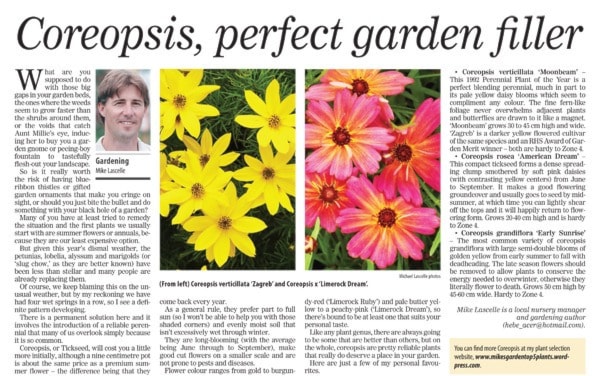What are you supposed to do with those big gaps in your garden beds, the ones where the weeds seem to grow faster than the shrubs around them, or the voids that catch Aunt Millie's eye, inducing her to buy you a garden gnome or peeing-boy fountain to tastefully flesh-out your landscape.
So is it really worth the risk of having blue-ribbon thistles or gifted garden ornaments that make you cringe on sight, or should you just bite the bullet and do something with your black hole of a garden?
Many of you have at least tried to remedy the situation and the first plants we usually start with are summer flowers or annuals, because they are our least expensive option.
But given this year's dismal weather, the petunias, lobelia, alyssum and marigolds (or 'slug chow,' as they are better known) have been less than stellar and many people are already replacing them.
Of course, we keep blaming this on the unusual weather, but by my reckoning we have had four wet springs in a row, so I see a definite pattern developing.
There is a permanent solution here and it involves the introduction of a reliable perennial that many of us overlook simply because it is so common.
Coreopsis, or Tickseed, will cost you a little more initially, although a nine centimetre pot is about the same price as a premium summer flower – the difference being that they come back every year.
As a general rule, they prefer part to full sun (so I won't be able to help you with those shaded corners) and evenly moist soil that isn't excessively wet through winter.
They are long-blooming (with the average being June through to September), make good cut flowers on a smaller scale and are not prone to pests and diseases.
Flower colour ranges from gold to burgundy-red ('Limerock Ruby') and pale butter yellow to a peachy-pink ('Limerock Dream'), so there's bound to be at least one that suits your personal taste.
Like any plant genus, there are always going to be some that are better than others, but on the whole, coreopsis are pretty reliable plants that really do deserve a place in your garden.
Here are just a few of my personal favourites.
• Coreopsis verticillata 'Moonbeam' – This 1992 Perennial Plant of the Year is a perfect blending perennial, much in part to its pale yellow daisy blooms which seem to compliment any colour. The fine fern-like foliage never overwhelms adjacent plants and butterflies are drawn to it like a magnet. 'Moonbeam' grows 30 to 45 cm high and wide. 'Zagreb' is a darker yellow flowered cultivar of the same species and an RHS Award of Garden Merit winner – both are hardy to Zone 4.
• Coreopsis rosea 'American Dream' – This compact tickseed forms a dense spreading clump smothered by soft pink daisies (with contrasting yellow centers) from June to September. It makes a good flowering groundcover and usually goes to seed by midsummer, at which time you can lightly shear off the tops and it will happily return to flowering form. Grows 20-40 cm high and is hardy to Zone 4.
• Coreopsis grandiflora 'Early Sunrise' – The most common variety of coreopsis grandiflora with large semi-double blooms of golden yellow from early summer to fall with deadheading. The late season flowers should be removed to allow plants to conserve the energy needed to overwinter, otherwise they literally flower to death. Grows 50 cm high by 45-60 cm wide. Hardy to Zone 4.
You can find more Coreopsis at my plant selection website, www.mikesgardentop5plants.wordpress.com.
Mike Lascelle is a local nursery manager and gardening author. Email him at hebe_acer@hotmail.com.
